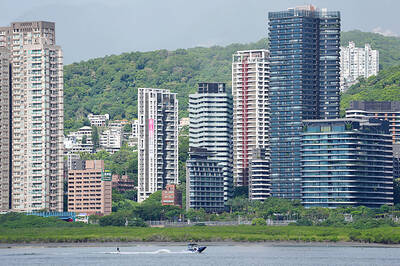After more than two years of negotiations with the Ministry of Economic Affairs, the 300 megawatt (MW) Hailong Offshore Wind 2A (海龍離岸風電) farm off the coast of Changhua County has finally come up with a plan that meets the ministry’s local content requirements.
Hailong’s developer Northland Power Inc, wind turbine manufacturer Siemens Gamesa Renewable Energy SA and ministry departments have had numerous meetings to figure out if and how the local supply chain can provide the 27 items that must be made locally for wind farms to qualify for the government’s higher feed-in-tariff rate.
Hailong has another 744MW of capacity it won in an auction that would not receive the favorable feed-in-tariff rate and is not subject to the localization requirements.

Photo: Lin Jing-hua, Taipei Times
“This has been a long journey, but we’ve been finally able to come to a consensus and it feels good to be finally able to start the project,” said Felipe Montero, head of Northland Power Taiwan and project director of Hailong Offshore Wind.
“Hailong looks forward to delivering on our localization commitments one by one,” the company said in a news release yesterday. “This will be an ‘anchor project’ that pushes forward the development of Taiwan into an export hub for the wind energy supply chain for the [Asia-Pacific] region.”
Hailong plans to work with partners Siemens Gamesa and CSBC-DEME Wind Engineering Co Ltd (台船環海風電) on the project.
“Hailong’s collaboration with CSBC-DEME was instrumental in bringing about Taiwan’s first domestic crane vessel, the Green Jade,” the release said. “With the ability to lift 4,000 [tonnes] using the latest DP3 [Dynamic Positioning 3] systems, the Green Jade will be finished by 2022 and start its service with the Hailong project.”
Hailong plans to use Siemens-Gamesa’s latest SG 14-222 DD 14MW turbines, and at 247m, they are one of the tallest turbines on the market, the release said.
The turbine “would be produced at Siemens-Gamesa’s nacelle assembly plant in Taichung harbor,” it said, adding that, apart from providing for domestic needs, Taichung would also become a regional export center.
Taiwan’s localization policy has been resisted by developers, who are mostly European.
They have said that the practice leads to cost overruns and there are not enough local suppliers that meet the exacting standards for making offshore wind turbine components.
Earlier this month, Cristina Lobillo Borrero, director for energy policy strategy and coordination at the European Commission, asked whether Taiwan’s local content policy might be in contravention of WTO rules.
She also said that the policy is bad for Taiwan’s energy users.
“Excessively strict demands regarding local content requirements would lead to higher costs, which would eventually be absorbed by consumers,” Borrero said.

Taiwan’s rapidly aging population is fueling a sharp increase in homes occupied solely by elderly people, a trend that is reshaping the nation’s housing market and social fabric, real-estate brokers said yesterday. About 850,000 residences were occupied by elderly people in the first quarter, including 655,000 that housed only one resident, the Ministry of the Interior said. The figures have nearly doubled from a decade earlier, Great Home Realty Co (大家房屋) said, as people aged 65 and older now make up 20.8 percent of the population. “The so-called silver tsunami represents more than just a demographic shift — it could fundamentally redefine the

Businesses across the global semiconductor supply chain are bracing themselves for disruptions from an escalating trade war, after China imposed curbs on rare earth mineral exports and the US responded with additional tariffs and restrictions on software sales to the Asian nation. China’s restrictions, the most targeted move yet to limit supplies of rare earth materials, represent the first major attempt by Beijing to exercise long-arm jurisdiction over foreign companies to target the semiconductor industry, threatening to stall the chips powering the artificial intelligence (AI) boom. They prompted US President Donald Trump on Friday to announce that he would impose an additional

China Airlines Ltd (CAL, 中華航空) said it expects peak season effects in the fourth quarter to continue to boost demand for passenger flights and cargo services, after reporting its second-highest-ever September sales on Monday. The carrier said it posted NT$15.88 billion (US$517 million) in consolidated sales last month, trailing only September last year’s NT$16.01 billion. Last month, CAL generated NT$8.77 billion from its passenger flights and NT$5.37 billion from cargo services, it said. In the first nine months of this year, the carrier posted NT$154.93 billion in cumulative sales, up 2.62 percent from a year earlier, marking the second-highest level for the January-September

Asian e-commerce giant Shein’s (希音) decision to set up shop in a historic Parisian department store has ruffled feathers in the fashion capital. Anger has been boiling since Shein announced last week that it would open its first permanent physical store next month at BHV Marais, an iconic building that has stood across from Paris City Hall since 1856. The move prompted some French brands to announce they would leave BHV Marais, but the department store had already been losing tenants over late payments. Aime cosmetics line cofounder Mathilde Lacombe, whose brand was among those that decided to leave following